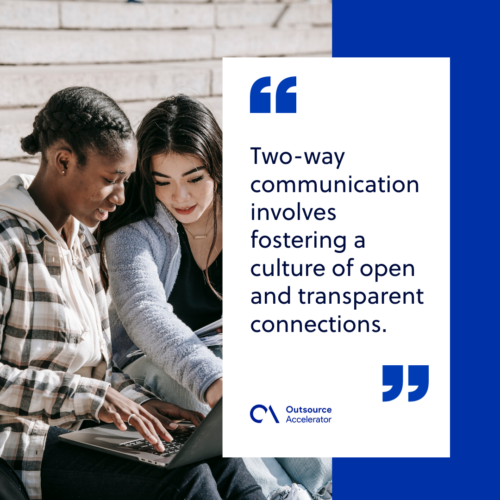Importance of understanding your internal audience

While external stakeholders often hold an organization’s attention, the internal audience’s importance should not be underestimated.
This group forms the nucleus of effective communication within a company.
A well-considered approach to the internal audience can foster unity, clarity, and business triumph.
This article explores the concept of an internal audience and discusses strategies you can use to build a culture of engagement.
What is an internal audience?
An internal audience refers to the group of individuals within an organization who receive internal communication and messaging. It may include employees of varying levels up to executives.
Communication with this group aims to inform, engage, and align the collective understanding and actions within the company.

Internal vs. External audience
External and internal audiences are two distinct groups organizations can communicate with. Both serve different purposes and require tailored strategies.
Striking a balance between internal and external communication is key to achieving organizational success and ensuring consistency in messaging across all channels.
Understanding the needs of internal and external audiences helps businesses build relationships and trust, & enhance their reputation in the market.
The table below shows the differences between the two.
| Internal audience | External audience | |
| Coverage | Individuals within the organization | Individuals and groups outside the organization, such as clients |
| Engagement | Actively involved in daily operations | Influence reputation, financial performance, and market presence |
| Communication focus | Emphasizes disseminating information about internal matters | Directed towards branding, marketing, customer relations, and compliance |
| Impact | Communication contributes to employee engagement, motivation, and a cohesive culture | Communication builds trust, attracts customers, satisfies investors, and ensures compliance |
Who makes up your internal audience?
The internal audience is composed of various individuals and groups within an organization who are vital to the day-to-day activities.
Here are some of the key components that make it up:
- Employees – This includes all levels of employees who work directly towards achieving organizational goals.
- Executives and management – This group includes top-level executives, department heads, and managers who set the organization’s direction.
- Board members – These members are appointed or elected to oversee the company’s activities and ensure its operations align with its mission and goals.
- Shareholders and investors – These people have ownership or financial interests in the organization and are concerned with its performance and profitability.
- Business partners and suppliers – While external entities, they still work closely with the business to deliver products, services, or support.
- Retirees – Former employees who still maintain a connection to the company can be considered, as they may have valuable insights that can contribute to success.
Strategies to effectively communicate with your internal audience
Consider implementing the following strategies to engage with your internal audience effectively:
Prioritize clear and consistent messaging
Craft clear, concise messages aligned with the organization’s values and goals. Consistency in messaging helps avoid confusion and establishes credibility, reinforcing the cultural identity of your brand.
Remember that communication is a key element in fostering a productive work environment, and precision in your messaging is essential for engaging and informing internal audiences effectively.
Encourage two-way communication
Two-way communication involves fostering a culture of open and transparent connections. It encourages employee feedback, suggestions, and questions.
Actively listen to your internal audience’s concerns and ideas to get an accurate picture of your organization.

Utilize multiple channels
Different employees prefer different communication channels. Utilize a mix of channels to cover all bases, including:
- Newsletters
- Bulletin board
- Team meetings
- Video conferencing
- Social collaboration tools
Tailor messages to different segments
Recognize the diversity within your internal audience and consider their needs and preferences when creating your messages.
Personalized communication ensures relevance and resonance with specific groups.
Incorporate visuals and multimedia
Incorporate visuals, infographics, videos, and other multimedia elements to make your communication more engaging and accessible.
These can enhance understanding and information retention.
Deliver regular updates
Keep your internal audience informed about organizational developments, goals, and achievements. Regular updates build transparency and help employees feel connected to the larger picture.
Recognize contributions and highlight success
Acknowledge and appreciate employees’ efforts and achievements. Recognition fosters a positive culture and motivates your internal audience to excel.
Train and develop
Provide necessary training and resources for effective communication skills within the organization. In this era of remote work, you can prioritize digital platforms.
Training can enhance efficiency and reduce the likelihood of misunderstandings.
Measure and evaluate
Establish metrics and feedback mechanisms to assess the effectiveness of internal communication efforts.
Use surveys, feedback sessions, and analytics to gather insights and make improvements.
Importance of the internal audience
Effectively understanding your internal audiences holds significant importance in shaping a company’s success and sustainability.
Several key aspects underscore this importance, including:
Alignment and consistency
Effective communication with the internal audience ensures everyone is aligned with the company’s goals, strategies, and values.
This alignment facilitates coordinated efforts, teamwork, and consistent decision-making.
Engagement and motivation
Focus on efforts that will make your internal audience feel informed, valued, and involved in the organization’s mission. They will likely be motivated, loyal, and willing to go the extra mile.
Change management
Effective communication with the internal audience becomes crucial during change or organizational transformations. It helps manage expectations, reduce resistance, and ensure a smooth transition.
Operational efficiency
A well-informed internal audience leads to reduced ambiguity, streamlined processes, and enhanced efficiency.
Because they have access to relevant information, employees can make informed decisions and work toward common objectives effectively.
By prioritizing internal and external communications, businesses can streamline operations, reduce misunderstandings, and enhance efficiency while projecting a professional image.

Organizational culture and employee satisfaction
An internal audience plays a vital role in shaping and nurturing the organization’s culture.
By maintaining open lines of communication, companies can foster positive relationships and a supportive work environment.
This, in turn, leads to satisfied workers who are more likely to stay.
Brand advocacy
A well-nurtured internal audience can also become brand advocates and ambassadors.
They can positively influence how the organization is perceived by clients, customers, and the external community.
Proper communication with internal audience is key
In the realm of business operations, the significance of internal communications should not be underestimated, as it serves as the lifeblood of organizational success.
Your internal audience serves as a crucial component of successful communication within your company.
Communication is the foundation for organizational cohesion, productivity, and growth.
Developing a robust communication strategy ensures that important information is disseminated efficiently and transparently.
As your business forges ahead, remember that the diverse perspectives of your internal audience can propel you to new heights if you’re willing to take advantage of them.







 Independent
Independent




